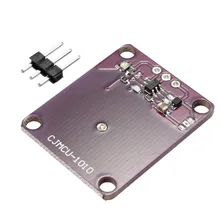In this example we look at the CJMCU-1010 module – this is based on the AT42QT101x
The AT42QT101x Single Key capacitive touch controller family provides an easy way to add a touch key to any application. It implements advanced filtering algorithm to offer robust operation in noisy environment. Sensitivity and low power modes can be configured as well.
The AT42QT1011 output will remain high as long as a touch is detected. No “Max On” time out.
-
- Number of Keys: One – configurable as either a single key or a proximity sensor
- Key outline sizes: 6 mm × 6 mm or larger (panel thickness dependent); widely different sizes and shapes possible
- Electrode design: Solid or ring electrode shapes
- PCB Layers required: One
- Electrode materials: Etched copper, silver, carbon, Indium Tin Oxide (ITO)
- Panel thickness: Up to 12 mm glass, 6 mm plastic (electrode size and Cs dependent)
- Key sensitivity: Settable via capacitor (Cs)
- Power consumption: 17 µA at 1.8 V typical
- Applications: Control panels, consumer appliances, IoT, proximity sensor applications, toys, lighting controls, mechanical switch or button replacement
Introduction:
1. Operating Voltage:2.0V-5.5V
2. Max Power Consumption:11.5uA;low power consumption 1.5uA
3. External Configure Pin Set Multiple Modes
4. High Reliability:chip built-in anti-shaking circuit
5. Can be used on glass,ceramic,plastic surface
6. Size:30*24mm
Connection
| Wemos Mini | CJMCU-1010 module |
| 3v3 | Vcc |
| Gnd | Gnd |
| D0 | OUT |
Parts List
Here are the parts I used
| Name | Links | |
| Wemos Mini | ||
| CJMCU-1010 | ||
| Connecting cables |
Code
const int TOUCH_BUTTON_PIN = D0; // Input pin for touch state
// Global Variables
int buttonState = 0; // Variable for reading button
void setup()
{
// Configure button pin as input
pinMode(TOUCH_BUTTON_PIN, INPUT);
pinMode(LED_BUILTIN, OUTPUT);
}
void loop()
{
// Read the state of the capacitive touch board
buttonState = digitalRead(TOUCH_BUTTON_PIN);
// If a touch is detected, turn on the LED
if (buttonState == HIGH)
{
digitalWrite(LED_BUILTIN, LOW);
}
else
{
digitalWrite(LED_BUILTIN, HIGH);
}
}
Links
http://ww1.microchip.com/downloads/en/devicedoc/40001948a.pdf


